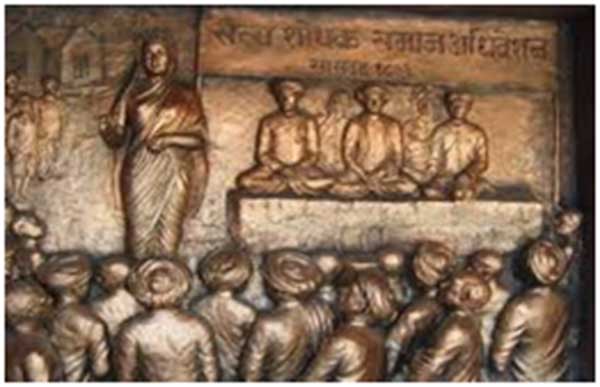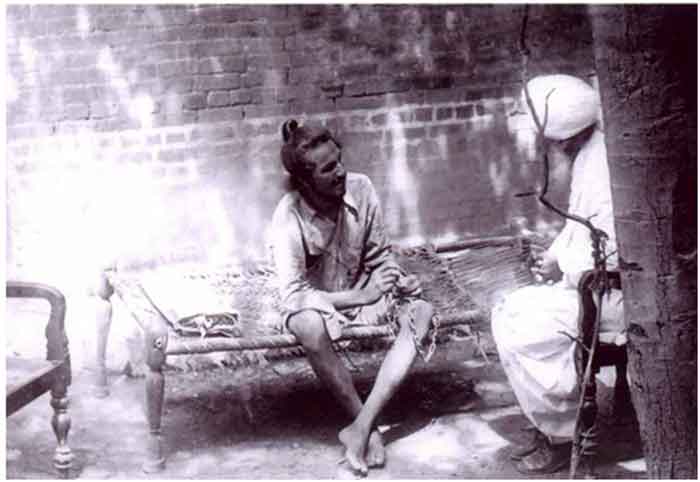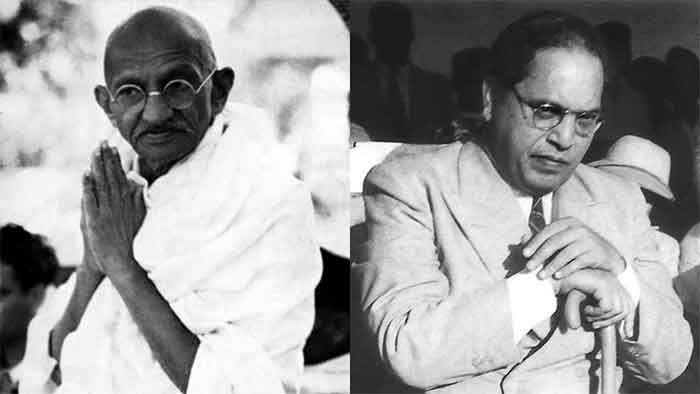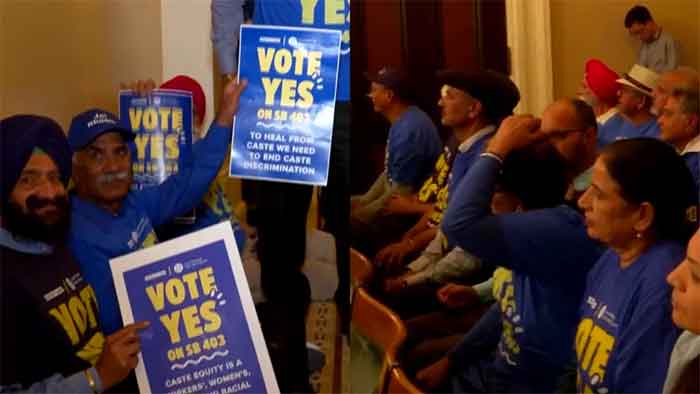
We pay our tributes to Mahatma Jothirao Phule, the founder of Satya Sodhak Samaj, on this 143rd year of its foundation, namely September 24, 1873.
Mahatma Jothirao Phule, and his wife Krantijyoti Savitribai Phule, declared war on brahmanic-casteist culture and religion. This Maharashtrian couple presented the first major anti-caste ideology and led a mass activism against the ascriptive norms and values. Their distinct brand of socio-cultural radicalism was based on uniting all the oppressed, whom they would call stree-shudra-atishudra, which included adivasis and Muslims as well.
Jothirao Phule during his social movement of initial 15 years had been propagating his views, preaching at public meetings, through leaflets and booklets the importance of education and exhorting the lower castes to educate their children and to redeem themselves from the evil customs, wicked prejudices and wily precepts imposed on them in the name of God by some priests and their cohorts. Jothirao resolved now to launch a movement in Maharashtra for liberation of lower castes from casteist thralldom. Awakening self-respect in the peasants and toiling masses, he infused courage in them to stand up against the poverty and social injustice and against the oppressive, unjust and inhuman priest craft and the caste system. His writings and his speeches focused Government attention on the grievances of the peasants and of the workers engaged by Government Engineering and Public works Department.
Jothirao wanted now to organise his followers and workers so that they might assimilate his rational ideas and bring them into effect. He strove hard to raise the Ati-Shudras to the level of the Shudras. He repeatedly said to his followers that lost rights are not secured without a struggle. Jothirao knew that the privileged castes are not only unsympathetic but also intolorent and that the discrimination-mongers would not easily give up their privileges, position and power. There was no question of their expecting to get any political rights as they had no strength and organization behind them. So Jothirao decided to set up an organization to preach his ideology. Accordingly Jothirao convened on September 24, 1873, a meeting of all his admirers and disciples at Poona. About sixty men from many important centres of Maharashtra state assembled. Jothirao made an introductory speech and explained the necessity of a central institution for the guidance of the movement. After some discussion and several other speeches, it was agreed to form an institution. Jothirao named this institution as “SatyaSodhak Samaj” (literally the Truth-Seeking Society).
Jothirao was elected first president and treasurer of the Satya Sodhak Samaj and Narayanrao Govindrao Kadalak was elected as its first secretary. The main objects of the samaj were;
- To redeem the Shudras and Ati-Shudras from the influence of Brahmanical scriptures under which the Brahmin priests fleeced them to make them conscious of their human rights and to liberate them from mental and religious slavery.
- All men are the children of one God, who is thus their parent.
- There is no requirement of intermediaries such as priests or preceptors to approach the Mother or Father to offer his/her prayer to God.
A member at Satya Sodhak Samaj had to take an oath in the name of God and emphasize the principle of the father-hood of God without idol worship. Membership of the Samaj was extended to all the castes including Mahars, Mangs, Jews and Muslims. The weekly meetings were held on Sundays at the places where branches of the Satya Sodhak Samaj were established. The subjects discussed were:
1) The necessity of the temperance and compulsory education.
2) Encouragement of Swadeshi goods.
3) Dislodging the priests from the position they held in the religious field.
4) Making arrangements for performing marriage at minimum expenses
5) Freeing men from the beliefs in silly and meaningless superstitions.
6) The main attack was upon the caste system and idol-worship.
7) Emphasis was also on the principle of the fatherhood of God and brotherhood of Man.
When Jothirao Phule established the Satya Sodhak Samaj, Savitribai became the head of the women’s section which included ninety female members. Moreover, she worked tirelessly as a school teacher for girls and led the Samaj as its President after his death. Deenbandhu publication, the mouthpiece of the Satya Sodhak Samaj, played an important role in SatyaSodhak Samaj’s movement. After Jothirao’s death in 1890 his spirited followers from different vastes like Marati(Kunbi) went on spreading the movement to the remotest parts of Maharashtra. Shahu Maharaj, the ruler of Kolhapur lend moral support to Satya Sodhak Samaj. In its new incarnation party carried on the work of superstition removal vigorously for some time, though in course of time it declined due to lack of leadership. Then the Sudra peasant caste leaders joined the Congress party, while the non-upper-caste backward Sudra’s and Athi-Sudra’s joined in the Independent Labour Party (ILP) established by B.R. Ambedkar, while poor peasants and the workers joined in the Communist party.
- The Anti-Brahmin Anti-caste movement organized by Mahatma Phule raises a real contradiction in Indian society – between Brahminical Agravarna against non-Brahminical Sudra, Athi-sudra (Bahujans). In other words the Bahujan movement was called by Mahatma Phule as a Social Democratic Revolutionary Movement, as well as a Social Justice Movement. After Phule’s death, the Brahminical Hindutva forces diverted the caste contradiction between Brahmin – non-Brahmin into Hindu(majority) – non-Hindu (minority) religious contradiction. At his time Ambedkar confined himself to untouchable caste minorities, i.e., Scs (his popular book – State’s and Minority) because he was helpless to maintain or to continue Phule’s Sudra, AthiSudra Bahujan majority.
This vaccum has never been filled in the era of post-independence India, though contemporary social and political scenario calls for the involvement of precisely a Bahujan organisation like the SatyaSodhak Samaj. Even today, Shudras who constitute the largest chunk of the popoulation but their presence in places of power, income and authority are negligibly low. Shudras have made the largest contribution to the building of India through their toil in the fields of agriculture and artisanship; they were the producers. The contribution of all other caste-groups pales in comparison with theirs. In terms of caste, the Indian society is divided into three broad sections – upper castes, OBCs and Dalit-Tribal communities. Identifiers of these communities are domination, contribution and pain, respectively. Shudras have complaints against the domination of the upper castes; they also have complaints against their contribution not getting due recognition. In addition, they have the complaint that almost nobody after Phule created an actual movement rather than mere reactions.
- The key points of the Satya Sodhak concept was Satya Dharma, Sama-Dharma, Buddha Dharma. It was an alternative concept against the Brahminical, Vaidic “Sanathana Dharma”(Manu-Dharma). Except in India the caste system was no where in any country in the world. Because of the specific Indian social reality, the Indian upper caste ruling classes protect the caste system with the help of Sanathana Dharma. So, Sanathana dharma has no universal world outlook. That truth was discovered by Mahatma Phule and it led him to go for an alternative voncept of Satya Sodhak. At the same time he established an alternative religion with a universal outlook i.e., “Sarvajanic Satya Dharma” . So, finally his Satya Sodhak Trinity was – One Caste, One Religion, One God.
Tata Sivaiah,President, Mahatma Jyotirao Phule & Krantijyoti Savitribai Phule Educational Circle, Msc mathematics in Hyderabad Central University.














































